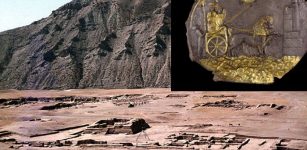Ancient Society In The Sahara Desert Rose And Fell With Groundwater – Study
Eddie Gonzales Jr. – MessageToEagle.com – With its low amounts of rain and soaring high temperatures, the Sahara Desert is often regarded as one of Earth’s most extreme and least habitable environments.
Cross-section showing how a foggara or qanat works. An upward sloping tunnel is built into a hillside with vertical shafts until groundwater is reached. The groundwater then flows down the tunnel. Figure courtesy of Frank Schwartz.
While the Sahara was periodically much greener in the distant past, an ancient society living in a climate very similar to today’s found a way to harvest water in the seemingly dry Sahara—thriving until the water ran out.
New research that will be presented Monday, 16 Oct., at the Geological Society of America’s GSA Connects 2023 meeting describes how a series of serendipitous environmental factors allowed an ancient Saharan civilization, the Garamantian Empire, to extract groundwater hidden in the subsurface, sustaining the society for nearly a millennia until the water was depleted.
“Societies rise and fall at the pleasure of the physical system, such that there are special features that let humanity grow up there,” says Frank Schwartz, professor in the School of Earth Sciences at The Ohio State University and lead author of the research study.
Monsoon rains had transformed the Sahara into a comparatively lush environment between 11,000 and 5,000 years ago, providing surface water resources and habitable environments for civilizations to thrive. When the monsoon rains stopped 5,000 years ago, the Sahara turned back into a desert, and civilizations retreated from the area—aside from an unusual outlier.
The Garamantes lived in the southwestern Libyan desert from 400 BCE to 400 CE under nearly the same hyper-arid conditions that exist there today and were the first urbanized society to become established in a desert that lacked a continuously flowing river. The surface water lakes and rivers of the “Green Sahara” times were long gone by the time the Garamantes arrived, but there was luckily water stored underground in a large sandstone aquifer—potentially one of the largest aquifers in the world, according to Schwartz.
Camel trade routes from Persia through the Sahara brought the Garamantes technology on how to harvest groundwater using foggara or qanats. This method involved digging a slightly inclined tunnel into a hillside, to just below the water table. Groundwater would then flow down the tunnel and into irrigation systems. The Garamantes dug a total of 750 km of underground tunnels and vertical access shafts to harvest groundwater, with the greatest construction activity occurring between 100 BCE and 100 CE.
Schwartz integrates prior archaeological research with hydrologic analyses to understand how the local topography, geology, and unique runoff and recharge conditions produced the ideal hydrogeologic conditions for the Garamantes to be able to extract groundwater.
Map location and satellite aerial imagery showing the region and landscape where ancient societies and Garamantes lived. Credit: NASA/Luca Pietranera
“Their qanats shouldn’t have actually worked, because the ones in Persia have annual water recharge from snowmelt, and there was zero recharge here,” says Schwartz.
The Garamantes had a significant streak of environmental luck, with the earlier wetter climate, appropriate topography, and unique groundwater settings, which made groundwater available with foggara technology. However, their luck ran out when groundwater levels fell below the foggara tunnels.
According to Schwartz, two trends are particularly concerning. First, extreme environments are becoming more prevalent around the world in countries like Iran. Second, it has become more common to use groundwater unsustainably.
“As you look at modern examples like the San Joaquin Valley, people are using the groundwater up at a faster rate than it’s being replenished,” says Schwartz. “California had a great wet winter this year, but that followed 20 years of drought. If the propensity for drier years continues, California will ultimately run into the same problem as the Garamantians. It can be expensive and ultimately impractical to replace depleted groundwater supplies.”
With no new water to replenish the aquifer and no surface water available, lack of water led to the downfall of the Garamantian Empire. The Garamantes serve as a cautionary tale for the power of groundwater as a resource, and the danger of its overuse.
Original source – The Geological Society of America
More info: 87: T142. Achieving Groundwater Security across Local-to-Regional Scales in the Anthropocene
Written by Eddie Gonzales Jr. – MessageToEagle.com Staff Writer












